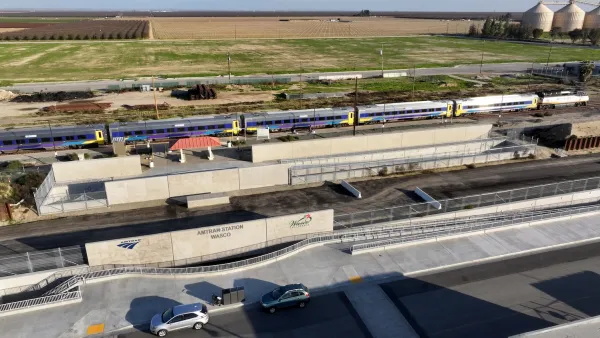These days, I have more in common with my nephew Sam than just about anyone else. He just turned 3. Sam is a train fanatic. Sure, he loves the children’s classics—Thomas the Tank Engine, the Polar Express—but he can also tell you about the Eurostar and the Shinkansen. His recent first ride on Amtrak was like his locomotive bar mitzvah: Today, I am a passenger. I’ve spent all semester working on a studio project making the case for true high-speed rail in the Northeast megaregion. I picked the studio because, like Sam, I’m thrilled by trains, but an added perk is that every time I come with some new picture or factoid about the big, fast choo-choos, I move up a notch in the running for Uncle of the Year.
These days, I have more in common with my nephew Sam than just about anyone else. He just turned 3.
Sam is a train fanatic. Sure, he loves the children's classics-Thomas the Tank Engine, the Polar Express-but he can also tell you about the Eurostar and the Shinkansen. His recent first ride on Amtrak was like his locomotive bar mitzvah: Today, I am a passenger.
I've spent all semester working on a studio project making the case for true high-speed rail in the Northeast megaregion. I picked the studio because, like Sam, I'm thrilled by trains, but an added perk is that every time I come with some new picture or factoid about the big, fast choo-choos, I move up a notch in the running for Uncle of the Year.
You can hardly blame either Sam or me for our rail fascination. With apologies to Bruce Springsteen, Tom Petty and the Federal Highway Administration, our national pulse has pretty much always been found on two tracks. Sure, cars are nice for rugged Americana individualism, but so are saddle sores and cheeseburgers. Classic songs about trains-"Freight Train Blues," "Long Train Runnin'," pretty much every song Tom Waits ever wrote-can wear the tires off of any ol' road tune.
But if the classic American narrative is all about trains, why are we so far behind in building high-speed rail? Obama just handed out $8 billion a few months ago to fund HSR projects around the country-a few billion here, a couple fractions there. But to get even one network up and running will cost at least 10 times that, and we're falling behind the rest of the world-fast.
Midway through the semester our studio traveled to London to play with their big, fast trains. (Sam was so jealous.) It was a great trip for a lot of reasons, and not just because I got to spend three hours wandering around the fantastic new London Transport Museum. (Even the transportation planners I was with thought three hours was a little excessive.)
Most significantly, the week we were there, Lord Adonis, the secretary of state for transport, announced plans for HS2, the U.K.'s newest high-speed line. Our studio watched the telly (this was Britain, after all) with rapt attention; the Member of Parliament sitting behind Lord Adonis alternately nodded off during the speech.
Our charge is to make the economic justification for high-speed rail in the Northeastern United States. When you pull the Northeast out from the rest of the country (which, let's be honest, much of the country would like us to do anyway), the profile is shockingly similar to the United Kingdom's. Measured in terms of population, GDP and length of the proposed rail line, the U.K. and the Northeast are almost identical. So it obviously behooved us to pay close attention to how they're building their line, and how they're building the political will to do so.
We present our findings next week (I know you're sitting on the edge of your seat), but we've learned that making an economic argument isn't just about counting how many dollars it'll take to lay down the track and buy fancy new rolling stock, and comparing it to how many tickets they'll be able to sell. When you're building a network with the potential of transforming and uniting a region that, taken collectively, has the sixth-largest GDP in the world, the only certain thing you can say about the benefits is that they'll be far-reaching, catalytic and virtually impossible to quantify. This could turn the Northeast megaregion into an international juggernaut, an economic and cultural competitor on the entire world's stage. (The same is true of the costs as well; someone in our studio pointed out that a preliminary cost-benefit analysis of the Federal-Aid Highway Act of 1956 could never have predicted the suburban sprawl that would take over the country.)
As with all projects of this magnitude, the funding will have to come from all over, and corners will have to be cut. If it helps, I know of one particular 3-year-old who will happily drive the trains for free.

Planetizen Federal Action Tracker
A weekly monitor of how Trump’s orders and actions are impacting planners and planning in America.

Maui's Vacation Rental Debate Turns Ugly
Verbal attacks, misinformation campaigns and fistfights plague a high-stakes debate to convert thousands of vacation rentals into long-term housing.

Restaurant Patios Were a Pandemic Win — Why Were They so Hard to Keep?
Social distancing requirements and changes in travel patterns prompted cities to pilot new uses for street and sidewalk space. Then it got complicated.

In California Battle of Housing vs. Environment, Housing Just Won
A new state law significantly limits the power of CEQA, an environmental review law that served as a powerful tool for blocking new development.

Boulder Eliminates Parking Minimums Citywide
Officials estimate the cost of building a single underground parking space at up to $100,000.

Orange County, Florida Adopts Largest US “Sprawl Repair” Code
The ‘Orange Code’ seeks to rectify decades of sprawl-inducing, car-oriented development.
Urban Design for Planners 1: Software Tools
This six-course series explores essential urban design concepts using open source software and equips planners with the tools they need to participate fully in the urban design process.
Planning for Universal Design
Learn the tools for implementing Universal Design in planning regulations.
Heyer Gruel & Associates PA
JM Goldson LLC
Custer County Colorado
City of Camden Redevelopment Agency
City of Astoria
Transportation Research & Education Center (TREC) at Portland State University
Jefferson Parish Government
Camden Redevelopment Agency
City of Claremont





























